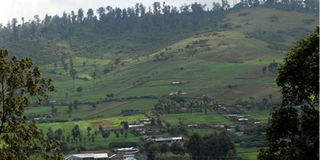Report reveals irony of Kenya’s lakeside counties with almost no forests

This 2012 photo shows human settlements at the foot of Logoman Forest, which is one of the Mau Forest Eastern Blocks. Siaya, Kisumu, Homa Bay, Migori and Kisii counties, which are around Lake Victoria, the world’s second largest fresh water lake, are ranked among the poorest in forest cover in Kenya. PHOTO | SULEIMAN MBATIAH | NATION
What you need to know:
- Kenya has an estimated forest cover of 6.9 per cent, more than five years after her 10 per cent target forest cover deadline lapsed.
- Nyeri County is the most forested county, with 38.03 per cent of its land covered. Elgeyo-Marakwet County comes in second 37.49 per cent forest cover.
- Ironically, Marsabit, Isiolo, Mandera, Turkana and Kitui counties, which are classified as arid or semi-arid areas, had better forest cover than the lakeside counties.
- The report, which also ranked counties on the loss of forest cover between 1990 and 2010, places Elgeyo-Marakwet as the most deforested county, having lost 46.31 per cent of its forest cover.
Counties in average climatic conditions and water availability are dragging Kenya further from attaining the internationally recommended 10 per cent forest cover.
Siaya, Kisumu, Homa Bay, Migori and Kisii counties, which are around Lake Victoria, the world’s second largest fresh water lake, are ranked among the poorest in forest cover in Kenya.
This is according to statistics released by the Kenya Water Tower Agency (KWTA) last week.
Kenya has an estimated forest cover of 6.9 per cent, more than five years after her deadline to achieve a 10 per cent forest cover lapsed.
KWTA Chief Executive Francis Nkako said the poor forest cover is a huge setback in safeguarding the country’s water catchments, whose economic value, he added, is largely underestimated.
“The Mau complex itself generates Sh110.5 billion annually from various activities dependent on the existence of the forest and apart from the Sh6 billion that Kenya loses annually due to deforestation, there is a risk of 70 per cent loss of the country’s water supply as it happened between 2000 and 2010. We also face health risks as well as loss of aquatic biodiversity,” Mr Nkako said.
The report, which also ranked counties on the loss of forest cover between 1990 and 2010, places Elgeyo-Marakwet as the most deforested county, having lost 46.31 per cent of its forest cover.
MOST FORESTED
Nyeri County is the most forested county, with 38.03 per cent of its land covered. Elgeyo-Marakwet County comes in second, at 37.49 per cent forest cover.
Lamu County is third with 33.9 per cent while Baringo (25.12 per cent) and Kericho (23.55 per cent) take fourth and fifth positions respectively.
Ironically, Marsabit, Isiolo, Mandera, Turkana and Kitui counties, which are classified as arid or semi-arid areas, had better forest cover than the lakeside counties.
Mandera, for example, had 3.04 per cent forest cover, more than triple Busia’s 1.01 per cent and Kisumu’s 0.44 per cent. Siaya was ranked worst with 0.42 per cent.
Counties with Kenya’s major water towers like the Mau and Mt Elgon have lost a lot of forest cover, signalling a ticking time bomb for Kenya's renewable water supply.
“While the country has 647 cubic metres of renewable freshwater resources per capita per annum in 1992, these water resources have declined by more than 200 cubic metres per capita per annum since that time.
"The close relationship between forest cover and hydrology makes it important to consider how forest cover decline has had its effect on our fresh water resources,” reads the KWTA report.
Nakuru County, for example, lost 32.8 per cent of its forest cover, close to thrice its current cover of 9.29 per cent. The county, which hosts part of the Mau, has been on the receiving end of this forest loss.
The KWTA report says rivers draining into Lake Nakuru have become seasonal. The lake shrunk by more than one kilometre, displacing its famous flamingos to other regional water bodies.
“To avert the water crisis threatening the survival of its national park, wild animals had to be at one point supplied with fresh water using tankers," notes the report.





